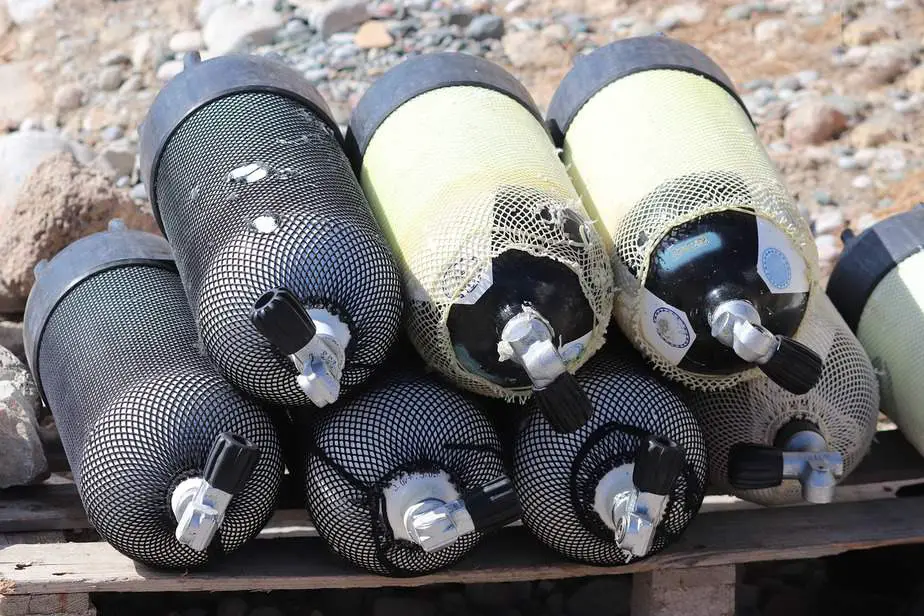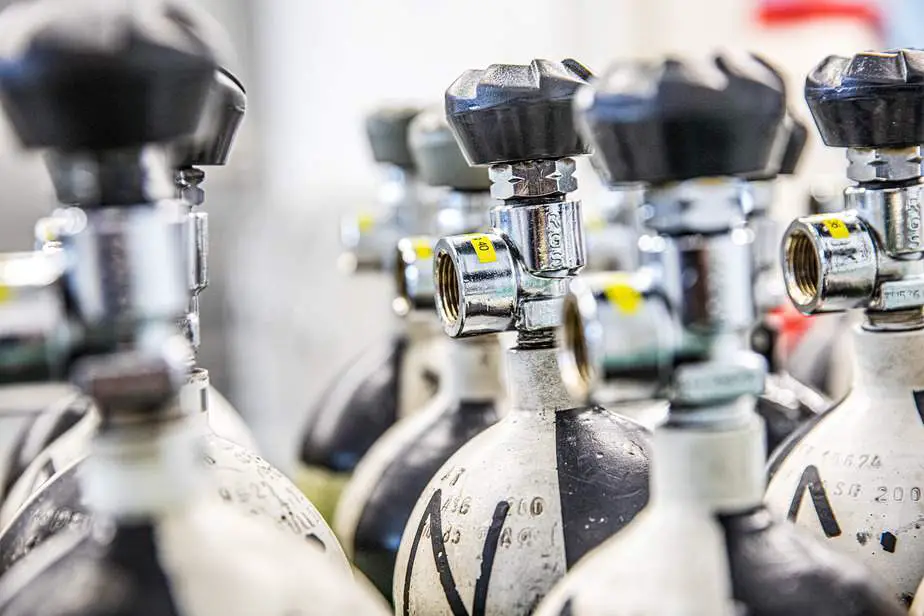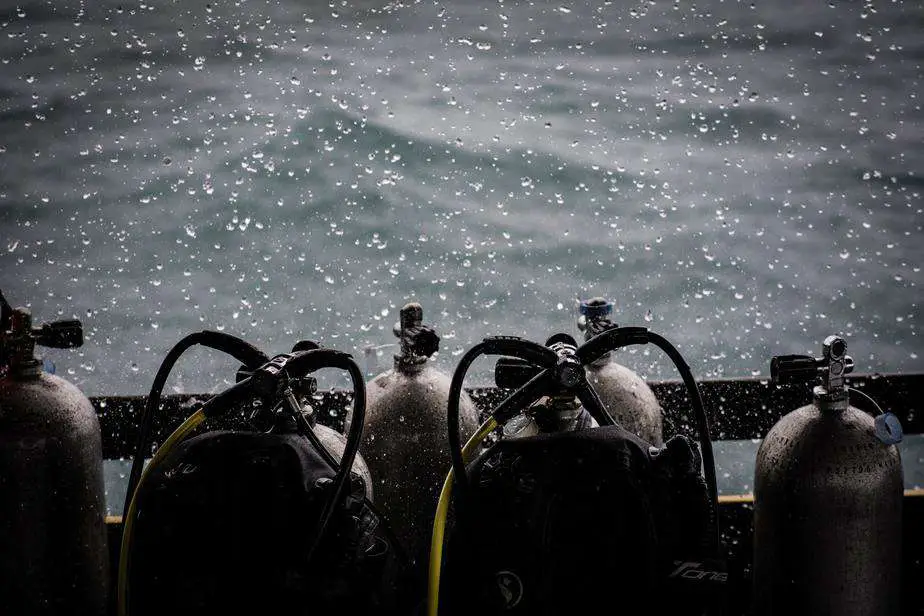Scuba tanks must be in tip-top condition in order to safely contain the pressurized gas(ses) stored within it. The gasses in the tank are compressed so much that there are literally several thousands pounds of pressure per square inch, and it would be a disaster if the tank were to release all of it at once.
What does any of this have to do with transporting a scuba tank? Transporting a scuba tank can go very wrong if you damage the tank or leave it exposed to the heat on a sunny day. Scuba tanks are also quite heavy, and if they roll around during transportation, they can easily damage your vehicle, other scuba equipment, or have it drop on someone’s foot.
Despite how scuba tanks may seem, they are actually quite delicate and require extreme care when transporting them. In order to safely transport your scuba tanks by car or air, you need to do the following:
- Orient the tank properly – horizontally, with valve facing outwards so it’s easier to grab when unloading.
- Restrict the tank’s movement.
- Protect the valve with a cap or wrap something around it.
- Keep the tank out of the heat.
- When traveling by plane, empty the tank and remove the valve so that TSA can inspect it, otherwise it will be denied.
In this article, we will go over how you can best transport your scuba tanks safely and effectively so that no one is exposed to any unnecessary risk. We will discuss how you can transport the tank by car and briefly go over how you can transport it by plane. Let’s go over the points above in more detail.
Why you need to be careful when transporting a scuba tank
In another article, we discussed the importance of storing your tank properly because even that can potentially cause an accident if done wrong, so it’s even more important to be careful when transporting it.
As we mentioned, scuba cylinders contain extreme pressures and anything that might weaken the structural integrity of the tank walls is a serious hazard. Even something as simple as dropping the tank can cause the integrity to deteriorate to the point that the tank would fail its next hydrostatic pressure test.
During transit, it’s also possible for the valve to get damaged or for the tank to leak. Given how much pressure is in a tank, a leak could be explosive. You’ll also need to be very careful not to get into an accident because that could also puncture the tank, causing an explosion. Have we got your attention yet?
Transporting scuba tanks by car
Most of the time, scuba tanks are transported by car. Most divers who are traveling by plane to their dive destination would prefer not to deal with the hassle of bringing their cylinder on a plane and would rather just rent their tanks. However, for local diving, transportation by car is the obvious choice.
Scuba tanks are quite heavy, weighing around 26 to 40 pounds (12 to 18 kg) with aluminum tanks generally weighing more than steel tanks due to how dense they need to be to withstand the pressure inside. This weight is just the tank alone, not including your other scuba gear. Not only that, but you might be diving with multiple tanks, and it gets too heavy to carry by hand quickly.
Therefore, you must be very careful when carrying the scuba tanks to and from your vehicle to the dock so that you do not accidentally drop one.
Carefully load the tanks

Most people carry the tank by forming a “V” with their index and middle finger with palms facing upward, and using these two fingers to grip the tank around the valve stem. We recommend carrying only one tank at a time so that if one hand gets tired, you can switch to the other.
Make sure that scuba tanks are the first thing you place in the trunk of your car. Not only are they heavy, but their cylindrical shape means they will roll around if they are on top.
Next, orient the tanks such that they are laying horizontally on their side with the valve facing the back, instead of horizontally. This ensures the tank won’t fall over and that the valve is easy for you to grab when unloading it.
Secure the tank
Since scuba tanks can roll, you want to restrict their movement. You can do this in a variety of ways.
You could try blocking it with other luggage or equipment. This needs to be done in all four directions so that it won’t roll side to side or shift front and back. If you’re extremely determined, you can install a special tank rack inside your car to fasten them securely.
Another option which is much cheaper is to use belt straps to fix them in place and put cardboard between the cylinders so that they don’t clang against each other. You can also consider bubble wrapping it so it can’t move at all while driving.
Protect the valve

Be wary of the scuba tank’s valve when you are loading and unloading. Make sure that it’s not in a position where other items can hit it and that the tank won’t slide forwards when the car is moving.
Valves are typically made of brass and covered in chrome, so they are not as durable as the rest of the tank. It’s pretty easy to tell when a valve is dinged up because it’ll probably be bent out of shape or scratched up.
If a valve gets slightly damaged it’s not the end of the world, but it’s an extra expense you’ll have to worry about. To avoid this, you can purchase cheap caps online specifically made to protect the valve, and there are caps for both DIN and Yoke tanks. An extra benefit of getting a valve cap is that it can prevent dust and debris from reaching the valve opening and O-ring.
Avoid heat

It is crucial that you do not leave scuba cylinders in the car too long or exposed to sunlight, especially during a hot summer day. The reason is the heat – heat will cause the air inside to expand, increasing the overall pressure, potentially risking an explosion. Based on anecdotes, explosions are probably unlikely, but the pressure might increase enough to pop the burst disk. Conversely, when it’s cooler, the pressure will slightly decrease.
Thus, it’s preferable if the cylinders are placed in a compartment with open air circulation so that it is continuously getting fresh, cool air. If you’re placing the tank in the trunk of your car, it’s unlikely that you have such a system, so just try not to leave the tank in the trunk for too long.
Conversely, if it’s not too hot out, then the heat inside the car will not be as much of a problem as well. We still recommend you keep it out of direct sunlight, and to go as far as to cover up the tank so the UV rays don’t reach the tank. We still don’t recommend leaving the tank in the car for long; you might forget it’s there, and the weather might suddenly get warmer.
Finally, you should avoid placing the scuba tank next to any components that generate heat because it’s possible it will heat the tank up excessively during the commute.
Legal considerations
Pressurized tanks are dangerous, of that there is no question. So are they legal for someone to be driving around? What if one gets into an accident?
The laws may be different in your country, but many countries do allow private, non-commercial divers to drive with scuba cylinders for their own personal use without the need for any transport documents or labels on the tank. The rules are stricter if you work for an organization or plan on using the tanks for your business.
You can read this article on what the laws regarding transporting pressurized cylinders are in the United States. For the most part, recreational divers are generally exempt from these laws because they are unlikely to be transporting enough pressurized tanks where the laws do apply to them. For commercial divers, instructors, dive centers and other businesses, you will be subject to different laws.
That said, so as not to be caught in a deadly accident and so that you can protect yourself from getting sued (note: we are not giving legal advice), make sure that you have done everything by the book as much as possible. That means you should pack the tanks in a safe manner similar to what is described above, and that the tanks you are bringing are your own tanks or rented for your own personal use.
Make sure that the tanks have passed the proper inspections – the yearly visual inspections and the hydrostatic pressure test every 5 years and that the date stamp and sticker hasn’t expired. Also, this really should not need to be said, but don’t drive drunk and don’t drive like an idiot; a car accident will be even more deadly if there are pressurized tanks involved.
Flying with scuba tanks

You must adhere to specific rules and regulations regarding the transport of compressed gas cylinders. These rules are laid out by the International Air Transport Association (IATA) and enforced by the Transportation Security Administration (TSA). There are also National regulations to comply with as well.
In the US, that means that the scuba tank must be emptied and the valve removed so that the TSA can safely and fully inspect the interior of the tank to ensure you aren’t concealing anything or traveling with anything dangerous. While the TSA follows the guidelines laid out by the IATA, regulations can change, so you should look them up each time you travel by plane with a scuba cylinder.
Currently, if the tank contains air or any other nontoxic, nonflammable gasses at a pressure of 2 bar at 20°C, it is considered “dangerous goods”. They’ll also want to inspect inside the tank, so you’ll need to open the valve all the way and take it off anyways. Again, you must completely empty your tank and remove the tank or else the tank will not be allowed on an airplane.
It doesn’t matter if the tank contains only a little bit of air, if you have aluminum instead of steel or vice versa, if it’s a pony tank or spare air; if it’s not empty with the valve removed, it’s not allowed on an airplane.
Exemptions
That said, there are exceptions to every rule. In the US, tanks with medical oxygen may be allowed on an airplane if the airline company is informed in advance and approves taking a full medical oxygen cylinder onboard. These rules apply only to planes regulated by the TSA or IATA; private planes are not regulated.
Empty scuba tanks are not restricted as hazardous materials, but the screening officials will require all valves to be opened for inspection, so you can save everybody some time and just remove it beforehand and put it (along with the metal washer, O-ring, etc.) in a bag to reinstall later.
Again, this advice applies to the United States only, and regulations may have changed, so it is your responsibility to check the most current regulations. It’s possible your home country and airline have different regulations that prohibit any and all scuba tanks, no exceptions. Therefore, the only surefire way to get access to a tank at your destination is to rent it from a local dive shop.
Summary
How can you safely transport scuba tanks? If you’re diving locally, you can simply load it up in your car and drive it where you need it. Make sure to put the tank at the bottom because it’s heavy and can roll around. Try to place other luggage or cardboard boxes around the tank to protect it and prevent it from rolling. Be careful with the valve because it is easily damaged. Don’t leave the tank inside the car for too long on a hot day because the heat can cause the air inside to expand. If you have a reliable scuba tank, it will probably withstand some abuse, but don’t let that be an excuse to drop your guard.
If you plan on bringing your own tank on an airplane, you’ll need to completely empty it and remove the valve so the screening officials can fully inspect it. It’s possible that your home country or national regulation completely prohibits bringing a tank of any kind on an airplane. To avoid any hassle, we recommend you simply rent a scuba tank from a local dive shop.


